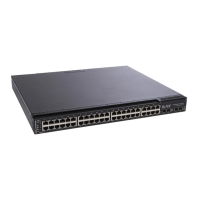262 RackSwitch G8000: Application Guide
Defining Areas
If you are configuring multiple areas in your OSPF domain, one of the areas must be
designated as area 0, known as the backbone. The backbone is the central OSPF
area and is usually physically connected to all other areas. The areas inject routing
information into the backbone which, in turn, disseminates the information into other
areas.
Since the backbone connects the areas in your network, it must be a contiguous
area. If the backbone is partitioned (possibly as a result of joining separate OSPF
networks), parts of the AS will be unreachable, and you will need to configure virtual
links to reconnect the partitioned areas (see “Virtual Links” on page 266).
Up to six OSPF areas can be connected to the G8000 with N/OS software. To
configure an area, the OSPF number must be defined and then attached to a
network interface on the switch. The full process is explained in the following
sections.
An OSPF area is defined by assigning
two
pieces of information: an area index and
an area ID. The commands to define and enable an OSPF area are as follows:
Note: The area option is an arbitrary index used only on the switch and does not
represent the actual OSPF area number. The actual OSPF area number is
defined in the area portion of the command as explained in the following
sections.
Assigning the Area Index
The
area
<area index>
option is actually just an arbitrary index (0–5) used only by
the G8000. This index number does not necessarily represent the OSPF area
number, though for configuration simplicity, it ought to where possible.
For example, both of the following sets of commands define OSPF area 0 (the
backbone) and area 1 because that information is held in the area ID portion of the
command. However, the first set of commands is easier to maintain because the
arbitrary area indexes agree with the area IDs:
•
Area index and area ID agree
area 0 area-id 0.0.0.0
(Use index 0 to set area 0 in ID octet
format)
area 1 area-id 0.0.0.1
(Use index 1 to set area 1 in ID octet
format)
•
Area index set to an arbitrary value
area 1 area-id 0.0.0.0
(Use index 1 to set area 0 in ID octet
format)
area 2 area-id 0.0.0.1
(Use index 2 to set area 1 in ID octet
format)
RS G8000(config)# router ospf
RS G8000(config-router-ospf)# area
<area index> area-id <n.n.n.n>
RS G8000(config-router-ospf)# area <area index> enable
RS G8000(config-router-ospf)# exit

